Lewin Benjamin (ed.) Genes IX
Подождите немного. Документ загружается.

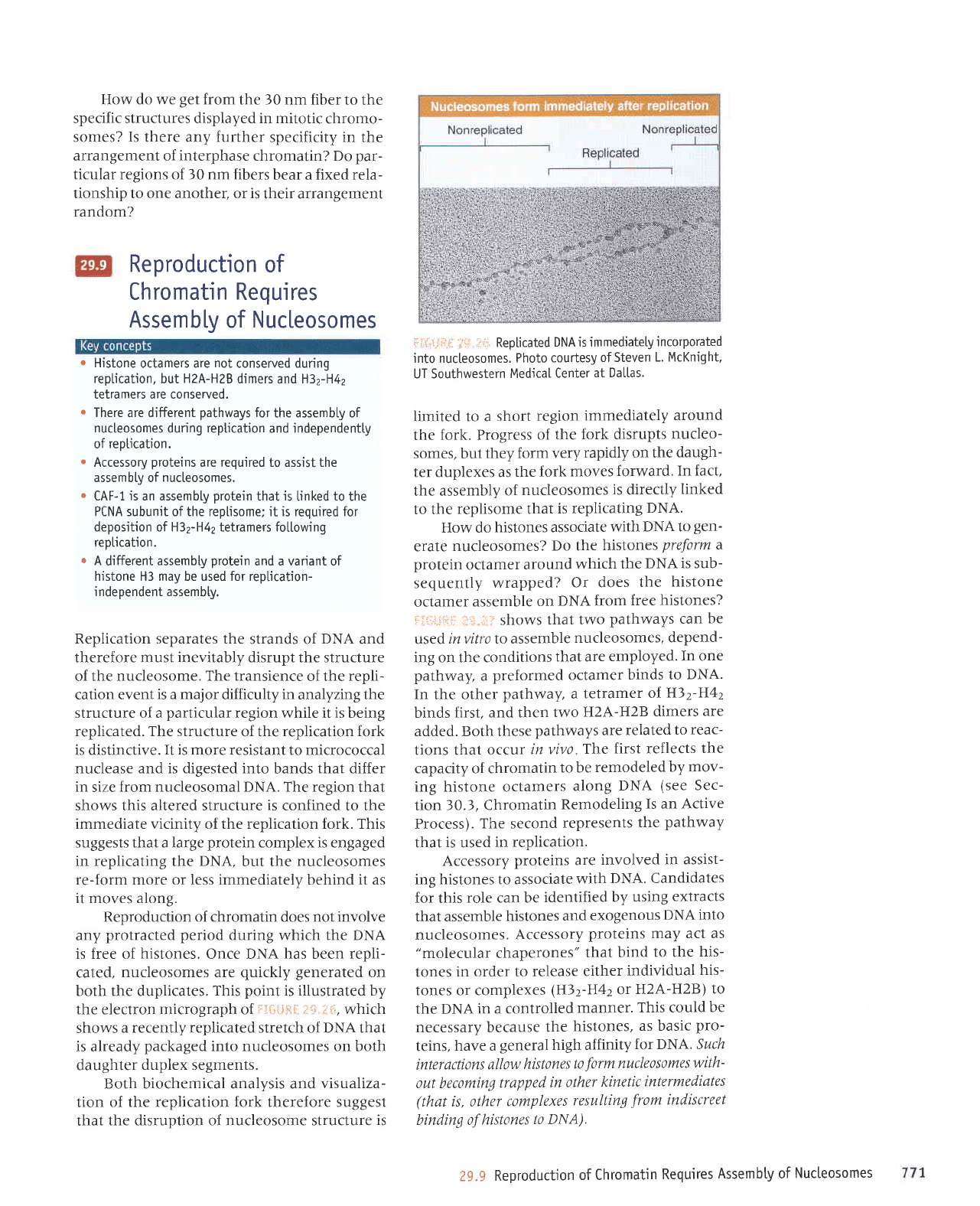
How do we
get
from
the 30 nm fiber to
the
specific structures displayed in mitotic
chromo-
somes? Is there any further
specificity in the
arrangement of
interphase
chromatin? Do
par-
ticular regions of 30 nm fibers
bear a fixed rela-
tionship to one another, or is
their arrangement
random?
Reproduction
of
Chromatin Requires
Assemb[y
of
Nucleosomes
o
Histone
octamers are
not
conserved during
reptication,
but
H2A-H28
dimers and H32-H4z
tetramers are conserved.
o
There are different
pathways
for
the assembly of
nucleosomes
during
replication
and independentty
of
reoUcation.
o
Accessory
proteins
are required to assist the
assembty of
nucleosomes.
.
CAF-1 is an assembly
protein
that
is
linked to the
PCNA subunit of the replisome; it is required for
deposition of H3z-H4z tetramers fotlowing
reptication.
r
A
different
assembty
protein
and a variant of
histone H3 may be used for replication-
independent assemb[y.
Replication separates the
strands of
DNA
and
therefore must inevitably disrupt the structure
of the
nucleosome. The transience
of the
repli-
cation event
is a major
difficulty in analyzing the
structure of a
particular
region while it is being
replicated. The structure
of
the replication fork
is distinctive.
It is
more resistant to micrococcal
nuclease and is digested into
bands
that differ
in
size
from nucleosomal DNA. The region
that
shows this altered structure
is
confined to the
immediate vicinity of the replication fork. This
suggests that a large
protein
complex is engaged
in replicating the
DNA,
but the nucleosomes
re-form more or less immediately behind it as
it moves along.
Reproduction of chromatin
does
not involve
any
protracted period
during
which
the DNA
is free of histones. Once DNA has been
repli-
cated,
nucleosomes are
quickly generated
on
both the duplicates.
This
point
is illustrated by
the electron micrograph of
ttri.{.i.iiii, ;lrri.!j*,
which
shows
a recently replicated stretch of DNA that
is already
packaged
into nucleosomes on both
daughter
duplex segments.
Both biochemical analysis and
visualiza-
tion
of the replication fork therefore suggest
that
the disruption of nucleosome structure
is
i:i s;
t
i
i;r
t
r:
r,1..,-l
ri:
Replicated
DNA is im
mediately i ncorporated
into nucteosomes. Photo
courtesy
ofSteven
L. McKnight,
UT Southwestern
MedicaI
Center
at Dat[as.
Iimited to a
short
region immediately
around
the
fork. Progress
of the
fork disrupts
nucleo-
somes, but they
form
very rapidly
on the
daugh-
ter duplexes as
the fork
moves
forward.
In fact,
the assembly
of
nucleosomes
is directly
linked
to the
replisome that
is replicating
DNA.
How do
histones associate
with
DNA to
gen-
erate
nucleosomes?
Do the
histones
preform
a
protein
octamer
around
which
the
DNA is sub-
sequently wrapped?
Or does
the
histone
octamer
assemble
on DNA
from
free histones?
iritiiririi: ,ri: .ii
shows
that two
pathways
can
be
used
ir vitr7 Io assemble
nucleosomes,
depend-
ing on the conditions
that are
employed.
In one
pathway,
a
preformed octamer
binds to
DNA.
In
the other
pathway,
a
tetramer
of.H3z-H4z
binds first,
and then
twoH2A-H2B
dimers
are
added. Both these
pathways
are
related
to reac-
tions that
occur in
vivo
The
first reflects
the
capacity of chromatin
to be
remodeled
by mov-
ing histone octamers
along
DNA
(see
Sec-
tion
10.3, Chromatin
Remodeling
Is an
Active
Process).
The second
represents
the
pathway
that
is
used
in replication.
Accessory
proteins are
involved
in assist-
ing
histones to associate
with
DNA. candidates
for this
role can be
identified
by
using
extracts
that assemble
histones
and
exogenous
DNA
into
nucleosomes.
Accessory
proteins may
act as
"molecular
chaperones"
that
bind
to the
his-
tones
in order to
release
either
individual
his-
tones or complexes
(H32-H42
or
H2A-H2B)
to
the DNA in
a controlled
manner.
This could
be
necessary because
the
histones,
as basic
pro-
teins,
have a
general high affinity
for DNA. Szcft
interactions
allow
histones
to
form
nucleosomes
with-
out becoming
trapped
in
other
kinetic
intermediates
(that
is, other
complexes
resulting
from
indiscreet
binding of
histones
to DNA).
29.9
Reproduction
of Chromatin
Requires
Assembty of
Nucleosomes
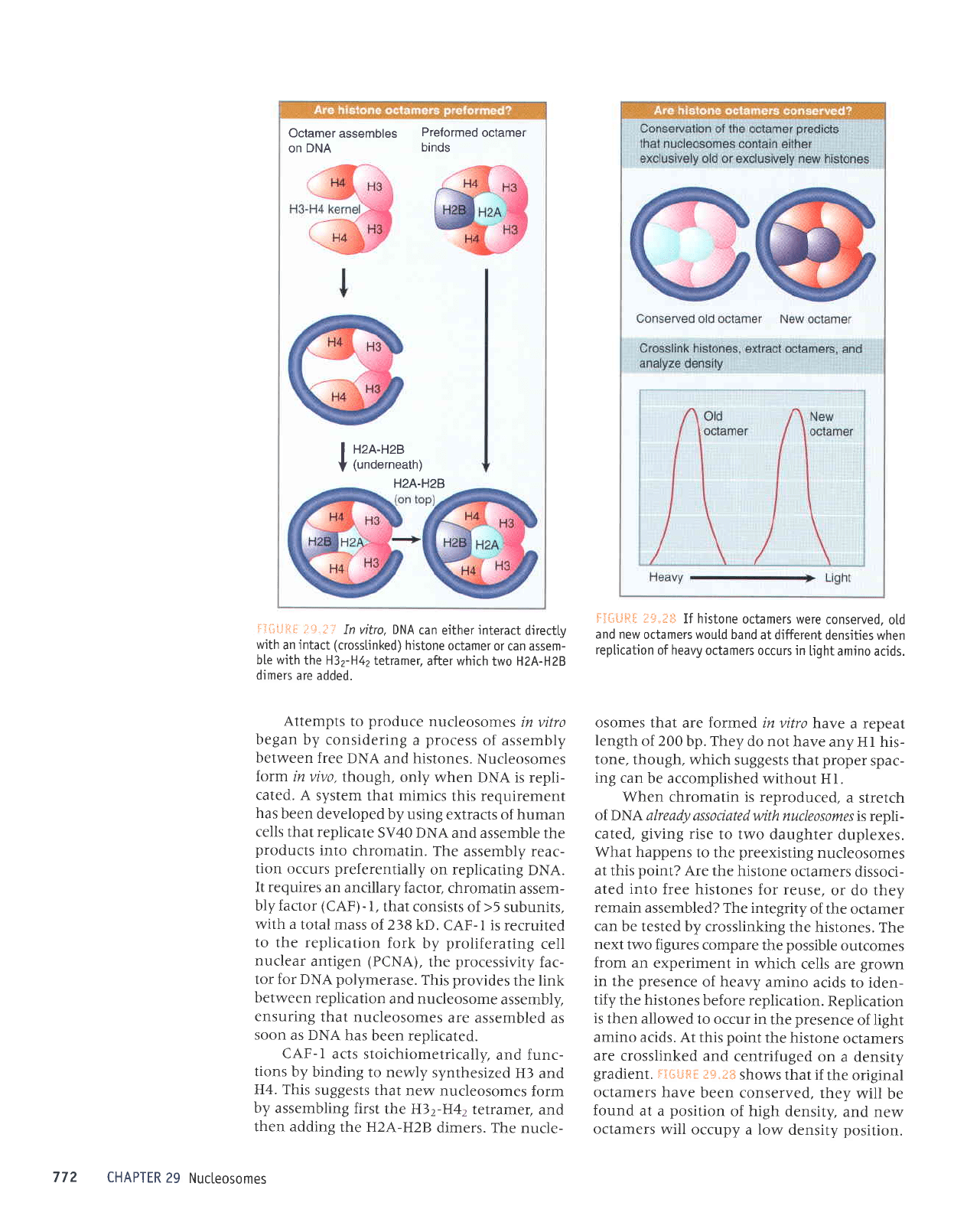
Octamerassembles
Preformedoctamer
on DNA
binds
I
uzn-Hza
|
(underneath)
H2A-H2B
=*i"l*[
,?i].1.:
In vifro, DNA
can
either
interact
directty
with
an
jntact
(crossl.inked)
histone
octamer
or can assem-
bte with
the H32-H42
tetramer,
after which
two H2A-H2B
dimers
are added.
Attempts
to
produce
nucleosomes
in vitro
began
by
considering
a
process
of assembly
between
Iree
DNA
and histones.
Nucleosomes
Iorm
in vivo,
though,
only when
DNA is repli-
cated. A
system
that mimics
this requirement
has
been
developed
by using
extracts
of human
cells that
replicate
SV40 DNA
and assemble
the
products
into
chromatin. The
assembly
reac-
tion occurs preferentially
on replicating
DNA.
It requires
an ancillary factor,
chromatin
assem-
bly factor
(CAF)-
1,
that consisrs
of
>5
subunits,
with a
total mass
of 238 kD.
CAF- I is
recruited
to
the replication
fork
by
proliferating
cell
nuclear
antigen
(PCNA),
the
processivity
fac-
tor for DNA polymerase.
This provides
the link
between
replication
and nucleosome
assembly,
:l#
:13 iix
il,";:,:"j
:ffi::;".:
"'
-''I
e d a s
CAF-1
acts stoichiometrically,
and func-
tions
by binding
to newly
synrhesized
H3
and
FI4. This
suggests
that
new nucleosomes
form
by
assembling
first
the H32-H42
tetramer,
and
then adding
the H2A-H2B
dimers.
The nucle-
CHAPTER
29
Nucteosomes
F{filJltE tS.**
If histone
octamers were
conserved,
old
and new
octamers woutd
band at different
densities when
replication
of heavy
octamers occurs in
light
amino acids.
osomes that
are
formed
in vitro
have
a repeat
length
of 200
bp. They do not
have
any Hl his-
tone.
though, which
suggests that
proper
spac-
ing can
be accomplished
without HI.
When
chromatin
is reproduced,
a stretch
oIDNA already
associated with
nucleosomes
is repli-
cated,
giving
rise
to two
daughter
duplexes.
What happens
to the
preexisting
nucleosomes
at this
point?
Are the histone
octamers
dissoci-
ated into
free histones
for reuse,
or do they
remain
assembled?
The integrity
of the
octamer
can
be tested by crosslinking
the histones.
The
next two figures
compare
the
possible
outcomes
from an
experiment in
which
cells are
grown
in the
presence
of heavy amino
acids
to iden-
tify the histones
before replication.
Replication
is
then allowed
to occur in
the
presence
of light
amino acids.
At this
point
the histone
octamers
are crosslinked
and
centrifuged
on a density
gradient. fl3fiLlSil
JS.ffS
shows
that if
the original
octamers
have
been conserved,
they
will
be
found
at a
position
of high
density,
and new
octamers
will
occupy a low
density
position.
772
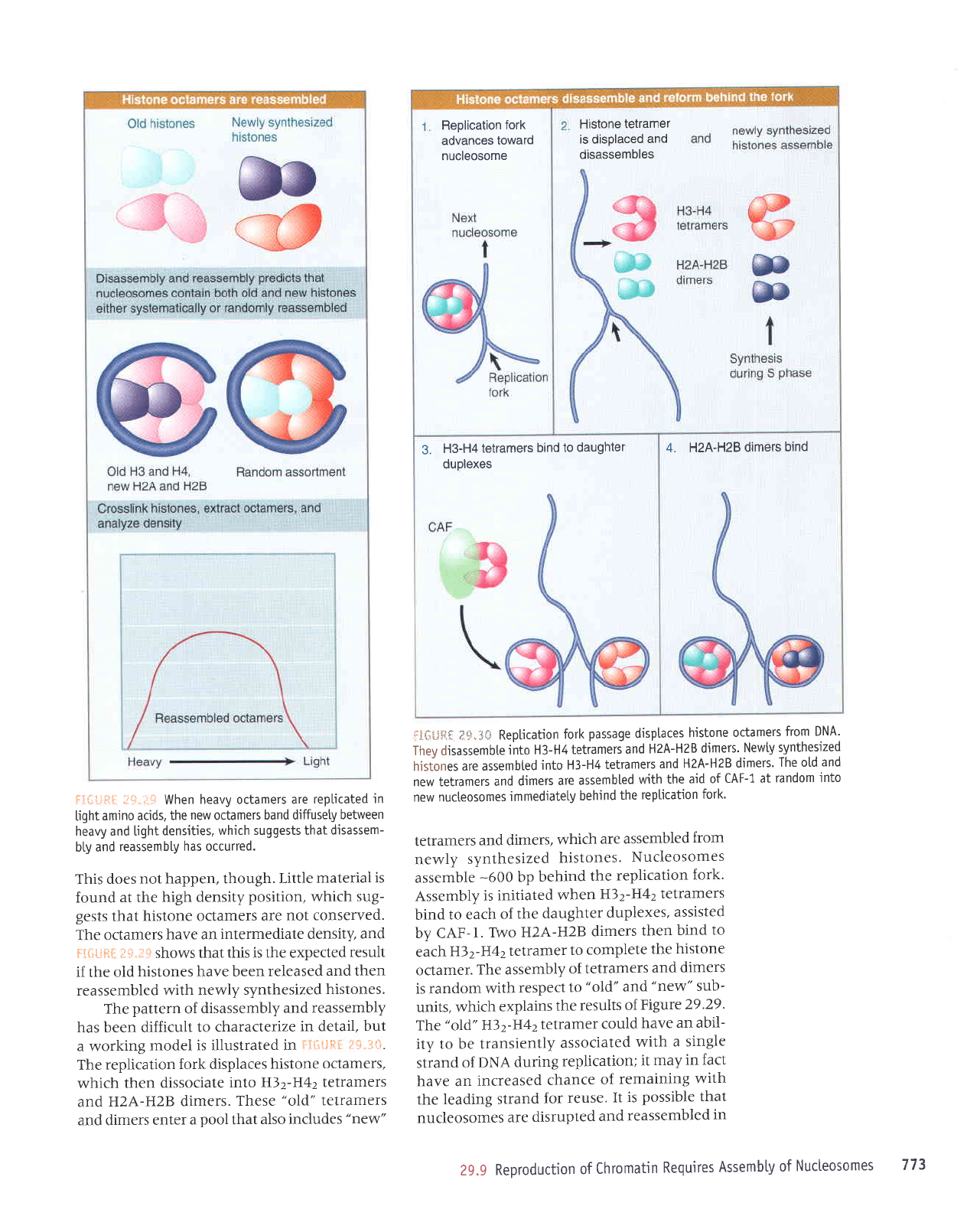
Histone
tetramer
is displaced
and
disassembles
Replication
fork
advances
toward
nucleosome
4. H2A-H2B
dimers
bind
3.
H3-H4
tetramers
bind
to daughter
duplexes
f,itlitre i*"
i:F
When
heavy octamers are
replicated
in
light
amino acids,
the
new
octamers
band diffuseLy
between
heavy and [ight
densities,
which suggests that
disassem-
bty and
reassembty has occurred.
This
does
not happen, though.
Little
material
is
found
at the
high density
position,
which
sug-
gests
that
histone octamers
are
not conserved.
The octamers
have an intermediate
density,
and
${{:;.:ft{: *+.:li.l shows that
this is the expected
result
if the
old histones
have been
released
and then
reassembled
with
newly synthesized
histones.
The
pattern
of
disassembly
and reassembly
has been difficult
to characterize
in detail,
but
a working
model
is illustrated
in
FEGiisf,
t*.3*.
The
replication
fork displaces
histone
octamers,
which
then
dissociate
into H32-H42
tetramers
and
H2A-H2B
dimers.
These
"old"
tetramers
and dimers
enter
a
Dool
that
also includes
"Dew"
F.i{;{Jlr.[
iiii,-t* RepLication
fork
passage
disptaces
histone
octamers
from
DNA.
Thev disassembl.e
into
H3-H4 tetramers
and
H2A-H2B
dimers.
Newty
synthesized
histones
are assembted
into
H3-H4
tetramers
and
H2A-H2B
dimers.
The otd
and
new tetramers
and
dimers
are
assembled
with
the
aid of
cAF-1
at
random
into
new
nucteosomes
immediatety
behind
the
reptication
fork.
tetramers
and dimers,
which
are assembled
from
newly
synthesized
histones.
Nucleosomes
assemble
-600
bp
behind
the
replication
fork.
Assembly
is
initiated
when
H32-H42
tetramers
bind
to each
of
the
daughter
duplexes,
assisted
by CAF-1.
TWo
H2A-H2B
dimers
then
bind
to
each
H32-H42
tetramer
to
complete
the
histone
octamer.
The assembly
of
tetramers
and
dimers
is random
with
respect
to
"old"
and
"new"
sub-
units, which
explains
the
results
of
Figure
29
.29
-
The
"old"
H32-H42tetramer
could
have
an abil-
ity
to be transiently
associated
with
a single
strand
of
DNA during
replication;
it
may
in fact
have an
increased
chance
of
remaining
with
the
Ieading strand
for
reuse.
It is
possible
that
nucleosomes
are
disrupted
and
reassembled
in
2g.g
Reproduction
of
chromatin
Requires
Assembly
of
Nucleosomes
773
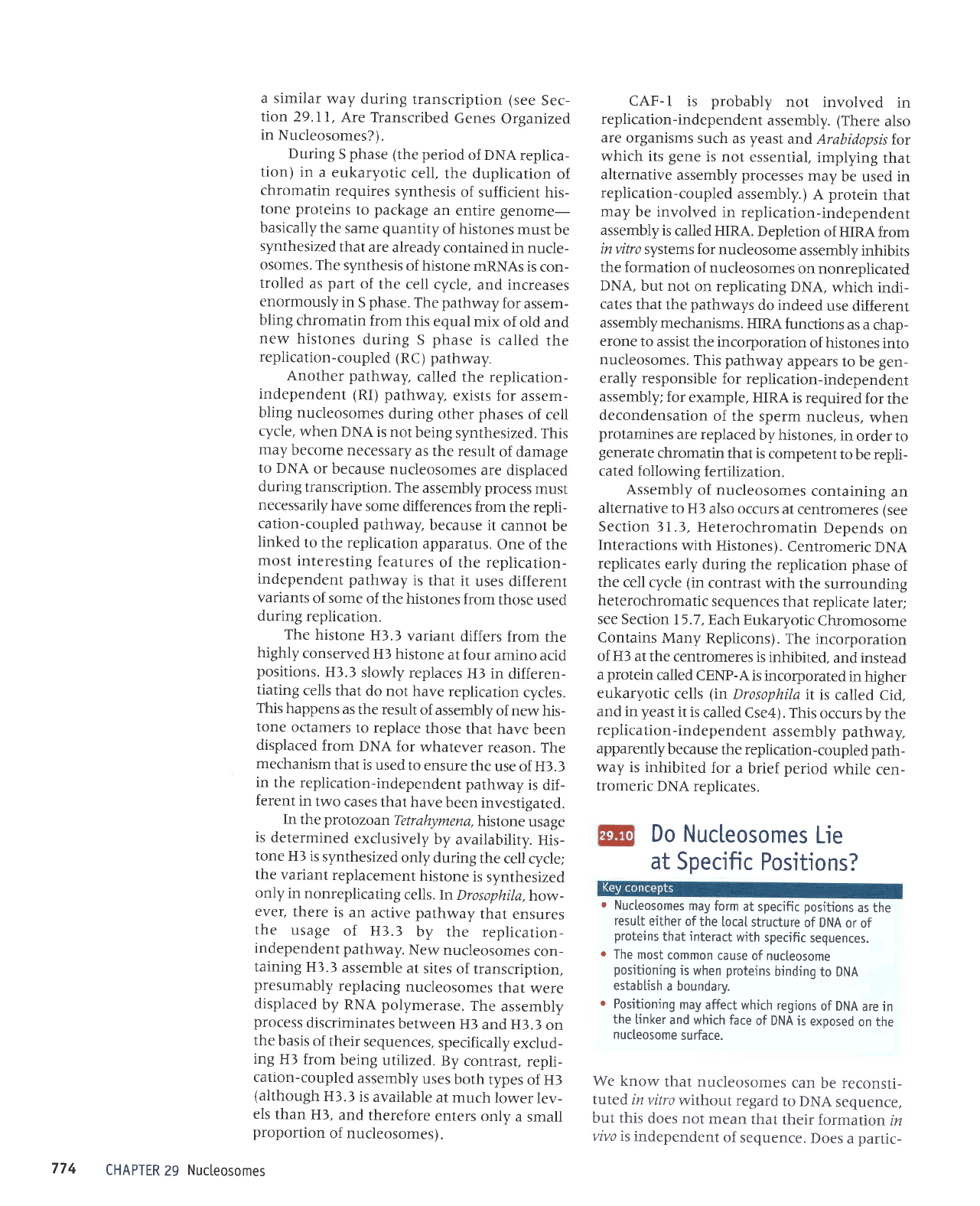
a similar
way during
transcription (see
Sec-
tion
29.I l,
Are Tlanscribed
Genes
Organized
in
Nucleosomes?).
During
S
phase (the
period
of DNA
replica-
tion)
in
a eukaryotic
cell,
the duplication
of
chromatin
requires
synthesis
of sufficient
his-
tone proteins
to
package
an
entire
genome-
basically
the same
quantity
of
histones
must
be
synthesized
that are
already
contained
in nucle-
osomes.
The
synthesis
of histone
mRNAs is
con-
trolled
as
part
of
the cell
cycle,
and increases
enormously
in
S
phase.
The pathway
for
assem-
bling
chromatin
from
this
equal mix
of
old and
new
histones
during
S
phase
is called
the
replication-coupled
(RC
)
pathway.
Another pathway,
called
the replication-
independent
(RI)
pathway,
exists
for
assem-
bling
nucleosomes
during
other phases
of
cell
cycle,
when
DNA
is not
being
synthesized.
This
may
become
necessary
as the
result
of damage
to DNA
or because
nucleosomes
are displaced
during
transcription.
The
assembly process
must
necessarily
have
some
differences
from
the repli-
cation-coupled
pathway,
because
it
cannot
be
Iinked
to the
replication
apparatus.
One of
the
most interesting
features
of the replication-
independent
pathway
is that
it
uses
different
variants
of some
of the
histones
from
those
used
during
replicarion.
The
histone
H3.3
variant
differs
from
the
highly
conserved
H3 histone
at four
amino
acid
positions.
H3.3
slowly
replaces
Hl in
differen-
tiating
cells
that
do not
have replication
cycles.
This
happens
as
the result
of
assembly
of new
his-
tone
octamers
to replace
those
that have
been
displaced
from
DNA
for
whatever
reason.
The
mechanism
that is
used
to ensure
the use
of H3.3
in
the replication-independent
pathway
is
dif-
ferent
in
two
cases
that have
been
investigated.
In the
protoz
oan
Tetrahymena,
histone
usage
is
determined
exclusively
by
availabiliry.
His-
tone
H3
is synthesized
only
during
the
cell cycle;
the
variant
replacement
histone
is
synthesized
only
in
nonreplicating
cells. ln
Drosophila,
how-
ever,
there
is an
active pathway
that
ensures
the
usage
of
H3.3
by
the
replication-
independent
pathway.
New nucleosomes
con-
taining
H3.3
assemble
at
sites
of transcription,
presumably
replacing
nucleosomes
that
were
displaced
by RNA polymerase.
The
assembly
process
discriminates
between
H3
and
H3.3
on
the
basis
of
their
sequences,
specifically
exclud-
ing
H3
from
being
utilized.
By
contrast,
repli-
cation-coupled
assembly
uses
both
types
of H3
(although
H3.3
is
available
at much
lower
lev-
els
than
Hl,
and
therefore
enters
only
a
small
proportion
of nucleosomes).
Nuc[eosomes
CAF-l
is
probably
not
involved
in
replication-independent
assembly. (There
also
are
organisms
such
as
yeast
and Arabidopsis
for
which
its
gene
is not
essential,
implying
that
alternative
assembly
processes
may
be used in
replication-coupled
assembly.)
A
protein
that
may be involved
in replication-independent
assembly
is
called HIRA.
Depletion
of HIRA
from
in vitro
systems for
nucleosome
assembly
inhibits
the formation
of nucleosomes
on nonreplicated
DNA,
but not
on replicating
DNA,
which
indi-
cates
that
the
pathways
do indeed
use
different
assembly
mechanisms.
HIRA
functions
as a
chap-
erone
to assist
the incorporation
of histones
into
nucleosomes.
This
pathway
appears
to be
gen-
erally responsible
for replication-independent
assembly;
for
example,
HIRA
is required
for
the
decondensation
of the
sperm
nucleus,
when
protamines
are replaced
by histones,
in
order
to
generate
chromatin
that
is competent
to
be repli-
cated
following
fertilization.
Assembly
of nucleosomes
containing
an
alternative
to H3
also occurs
at
centromeres
(see
Section
31.3,
Heterochromatin
Depends
on
Interactions
with Histones).
Centromeric
DNA
replicates
early during
the
replication phase
of
the
cell cycle
(in
contrast
with
the surrounding
heterochromatic
sequences
that
replicate
later;
see Section
15.7,
Each Eukaryotic
Chromosome
Contains
Many
Replicons).
The
incorporation
of H3 at
the centromeres
is inhibited,
and instead
a
protein
called
CENP-A
is incorporated
in higher
eukaryotic
cells
(in
Drosophila
it
is
called
Cid,
and
in
yeast
it is
called
Cse4). This
occurs
by the
replication-independent
assembly
pathway,
apparently
because
the replication-coupled
path-
way is inhibited
for
a brief
period
while
cen-
tromeric
DNA
replicates.
Do
Nucleosomes
Lie
at
Specific
Positions?
r
Nucteosomes
may
form
at specific
positions
as the
resutt
either
of
the [oca[
structure
of DNA
or
of
proteins
that interact
with
specific
sequences.
o
The
most
common
cause
of nucteosome
positioning
is
when
proteins
binding
to DNA
estab[ish
a boundary.
r
Positioning
may
affect
which regions
of DNA
are in
the
linker
and which
face
of DNA
is
exposed
on the
nucleosome
surface.
We know
that nucleosomes
can
be reconsti-
tuled
in vitro
wilhout
regard
to DNA
sequence,
but
this
does not
mean
that
their
formation
in
tzivo is
independent
of
sequence.
Does
a
partic-
774
CHAPTER
29
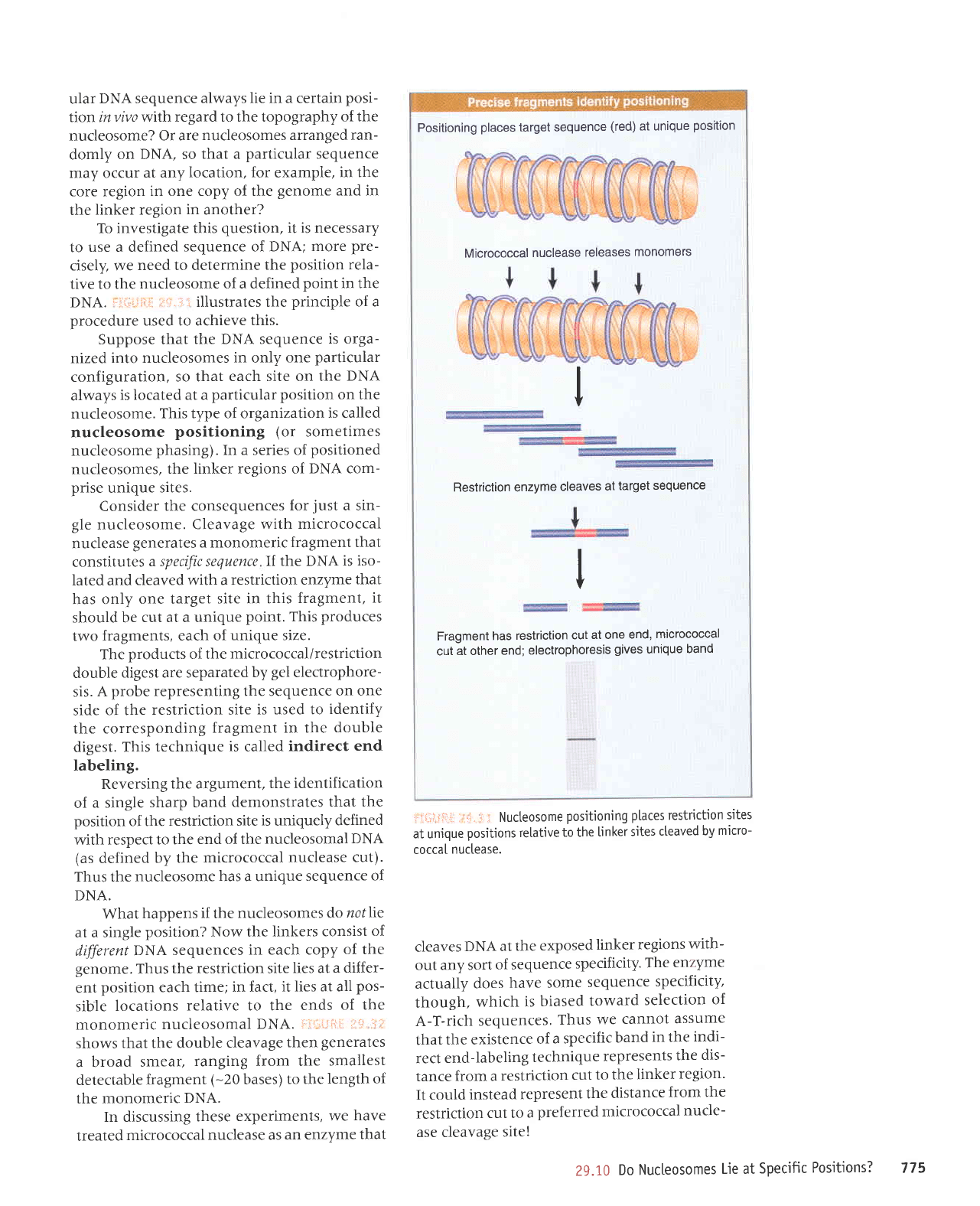
ular
DNA sequence
always lie in a certain
posi-
tion in
vivo w\th regard to the topography
of the
nucleosome?
Or are
nucleosomes arranged ran-
domly
on DNA, so
that a
particular
sequence
may occur
at any location,
for
example,
in the
core region
in one copy of the
genome
and in
the
linker region
in
another?
To
investigate this
question,
it is necessary
to
use a defined
sequence of DNA;
more
pre-
cisely, we
need to determine
the
position rela-
tive to the
nucleosome of a defined
point
in the
DNA.
:-;rl,r:tii
,i1:.'r l
illustrates the
principle
of a
procedure
used to achieve
this.
Suppose that
the DNA sequence
is orga-
nized
into nucleosomes
in
only
one
particular
configuration,
so that
each site on the
DNA
always
is
located at a
particular position
on the
nucleosome.
This type of organization
is called
nucleosome
positioning
(or
sometimes
nucleosome
phasing).In
a series of
positioned
nucleosomes,
the linker regions of
DNA com-
prise
unique
sites.
Consider
the consequences
for
just
a sin-
gle
nucleosome.
Cleavage
with micrococcal
nuclease
generates
a monomeric
fragment that
constitutes
a specific sequence
If. the DNA
is iso-
lated and
cleaved with a
restriction enzyme
that
has only
one target
site in this
fragment,
it
should be
cut at a unique
point. This
produces
two fragments,
each of
unique size.
The
products
of the
micrococcal/restriction
double
digest are separated
by
gel
electrophore-
sis.
A
probe
representing the sequence
on one
side
of the
restriction site
is used to
identify
the corresponding
fragment in the
double
digest.
This
technique
is
called
indirect
end
labeling.
Reversing
the argument,
the identification
of
a single
sharp band
demonstrates
that the
position
of the
restriction site
is
uniquely
defined
with
respect to the
end of the nucleosomal
DNA
(as
defined
by the
micrococcal nuclease
cut).
Thus
the nucleosome
has a unique
sequence
of
DNA.
What
happens if the
nucleosomes do
rollie
at a single
position?
Now the
linkers consist
of
different
DNA
sequences
in each copy
of the
genome. Thus
the restriction site
lies at
a differ-
ent
position
each time;
in fact,
it lies at all
pos-
sible
locations
relative to the
ends
of the
mOnomeriC
nuCIeOSOmal
DNA.
.i;ji,i,flil,
,r1ir,
jrl:
shows
that the double
cleavage
then
generates
a broad
smear,
ranging from the
smallest
detectable
fragment
(-20
bases)
to the
length ot
the monomeric
DNA.
In discussing
these
experiments,
we
have
treated
micrococcal
nuclease as
an enzyme
that
f:iili.iiii:
;,lil.
I
I
Nucteosome
positioning
ptaces
restriction
sites
at unique
positions retative
to the
[inker
sites
cteaved
by
micro-
coccaI
nuctease.
cleaves
DNA at
the
exposed
linker
regions
with-
out
any sort
of sequence
specificity.
The
enzyme
actually
does
have
some
sequence
specificity,
though,
which is
biased
toward
selection
of
A-T-rich
sequences.
Thus
we
cannot
assume
that
the existence
of
a specific
band
in the
indi-
rect
end-labeling
technique
represents
the
dis-
tance
from a
restriction
cut
to the
linker
region.
It could
instead
represent
the
distance
from
the
restriction
cut to
a
preferred
micrococcal
nucle-
ase cleavaqe
site!
Positioning
places
target sequence
(red)
at
unique
position
Restriction enzyme
cleaves
at
target
sequence
I
I
i
Fragment
has
restriction
cut
at one
end,
micrococcal
cut
at other
end;
electrophoresis
gives
unique
band
Micrococcal
nuclease
releases
monomers
29.L0
Do Nucteosomes
Lie at
Specific
Positions?
775

.!"
.'
In
the absence
of nucleosome
Dosition-
ing,
a restriction
site
[ies at
at[
possibte
Locations
in
djf-
ferent
copies
of the
genome.
Fragments
of
at[
possib[e
sizes are
produced
when
a restriction
enzyme
cuts
at a
target
site
(red)
and
micrococcaI
nuctease
cuts at
the
junctions
between
nucleosomes (green).
This
possibility
is
controlled
by treating
the
naked
DNA in
exactly
the
same
way
as the
chro-
matin.
If
there
are
preferred
sites
for micrococ-
cal nuclease
in the
particular
region,
specific
bands
are found.
This pattern
of bands
can
then be
com-
pared
with
the
pattem
generated
from
chromatin.
A
difference
between
the
control
DNA
band
pattern
and
the
chromatin pattern
provides
evi-
dence
for
nucleosome
positioning.
Some
of the
bands
present
in
the
control
DNA
digest
may
disappear
from
the nucleosome
digest,
indicat-
ing
that preferentially
cleaved positions
are
unavailable.
New bands
may
appear
in the
nucleosome
digest
when
new
sites
are rendered
preferentially
accessible
by the
nucleosomal
organization.
Nucleosome
positioning
might
be accom-
plished
in
either
of
two
ways:
.
It is
intrinsic:
Every
nucleosome
is deposited
specifically
at a
particular
DNA
sequence.
This
modifies
our
view
of the
nucleo-
some
as a
subunit
able
to form
between
any
sequence
of DNA
and
a histone
octamer.
CHAPTER
29
Nucteosomes
.
It is
extrinsic:
The
ftrst
nucleosome
in a
region
is
preferentially
assembled
at a
particular
site. A
preferential
starting point
for
nucleosome
positioning
results
from
the
presence
of a
region
from
which nucle-
osomes
are excluded.
The
excluded
region provides
a boundary
that
restricts
the
positions
available
to the
adjacent
nucleosome.
A series
of nucleosornes
may
then be
assembled
sequentially,
with a
defined repeat
length.
It is now
clear
that the
deposition
of his-
tone
octamers
on DNA is
not random
with
regard
to sequence.
The
pattern
is intrinsic
in
some
cases, in
which it
is determined
by
struc-
tural
features
in DNA.
It is
extrinsic
in
other
cases.
in which
it results
from
the interactions
of other
proteins
with the
DNA
and/or
histones.
Certain
structural features
of DNA
affect
placement
of histone
octamers.
DNA
has intrin-
sic
tendencies
to
bend in
one direction
ratner
than
another;
thus A-T-rich
regions
locate
so
that the
minor
groove
faces
in toward
the
octamer,
whereas
G-C-rich
regions
are arranged
so
that the
minor
groove
points
out. Long
runs
of dA-dT
(>8
bp)
avoid
positioning
in
rhe
cen-
tral superhelical
turn
of the core.
It is
not
yet pos-
sible
to sum
all
of the relevant
structural
effects
and
thus entirely predict
the
location
of a
par-
ticular
DNA
sequence with
regard
to the
nucle-
osome.
Sequences
that
cause
DNA
to
take up
more
extreme
structures
may
have
effects
such
as
the exclusion
of nucleosomes,
and
thus
could
cause
boundary
effects.
Positioning
of nucleosomes
near
bound-
aries is
common.
If
there is
some
variability
in
the
construction
of nucleosomes-for
exam-
ple,
if
the length
of
the linker
can vary
by,
say,
l0
bp-the
specificity
of locarion
would
decline
proceeding
away from
the first,
defined
nucle-
osome
at the
boundary.
In
this
case,
we might
expect
the
positioning
to be
maintained
rigor-
ously
only
relatively
near
the
boundary.
The location
of DNA
on nucleosomes
can
be described
in
two
ways.
l.iL,;tii'.
::t;i,i.:
shows
that
translational positioning
describes
the
position
of DNA
with regard
to
the
boundaries
of
the nucleosome.
In
particular,
it
determines
which
sequences
are found
in
the linker
regions.
Shifting
the
DNA
by l0
bp brings
the nexr
turn
into
a linker
region.
Thus
translational
position-
ing
determines
which
regions
are
more
acces-
sible
(at
least
as
judged
by
sensitivity
ro
micrococcal
nuclease
)
.
DNA
lies
on the
outside
of
the historre
octamer.
As
a result,
one
face
of anv
Darticular
776
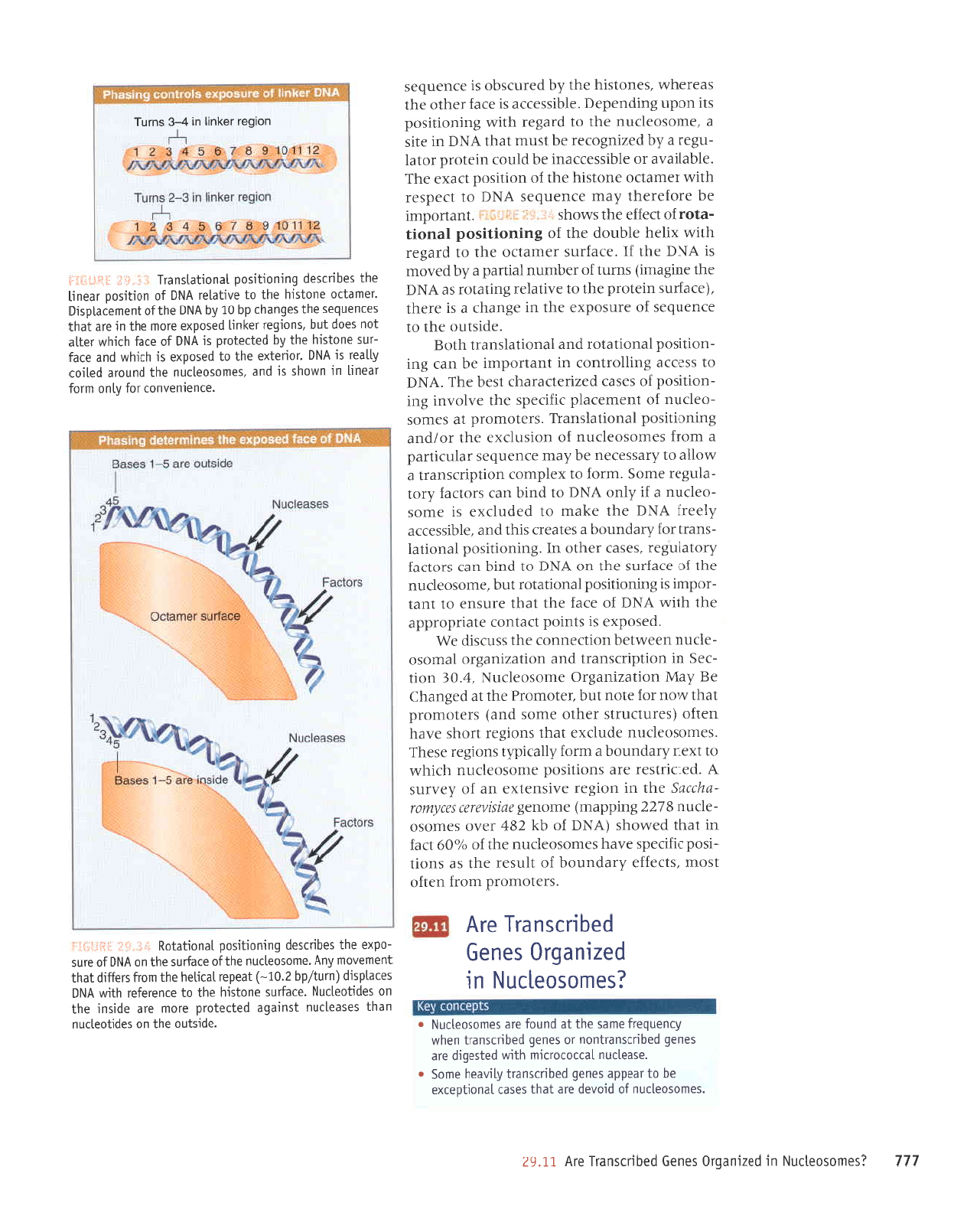
LLL
asauosoallnN
ur
pazruPDjO
saua9
paqulsuPrl
arv
II'62
'sourosoolJnu
J0
pro^ep
olP
leq]
sasel
lPuoqoalxo
aq ol leedde
saua6
poqu)suetl
Alt^Paq
ouos
.
'aspalrnu
lPlrolorlrru
qllM
polsaE!p o.lP
seue6
poqulsuPlluou
lo
saua6
paqulsuel] ueqM
fruenbar; aups aql
lp
punoJ
are souosoallr'lfrl
o
eseuosoallnN
ut
pazruP6J0
saua!
paqulsuPll
aJV
'sJaloruoJcl
luoJl
UJ]JO
tsolll
's])eJJJ
^JPpunoq
Jo
llnsJr
eql
se suoll
-rsod
f,rJDJds
JAeq seuosoalJnu
eql
p
o/o09
lJe!
uI
]eq]
pJMoqs
(vNo
Io
q4
a8v
re^o
seuroso
-allnu
gLZZB:o;rdderu)
auroua8
alsmafi)
sillhulJ
-DLp)aS
eqt ur uor8ar
JAIsuJlxJ
ue
1o
.{.anrns
v
'palJrJlsaJ
Jre suolllsod
JurosoJlJnu
qJIqM
ot
txJU
fuepunoq
e ur.ro;
.d1eld^dt suorSar
asaql
'sJurosoJIJnu
JpnlJXJ
lpr{l
suor8ar
uoqs
JAeq
uat;o
(sarnlJnJls
raqlo auos
pue) sralourord
leql
/!tou JoJ elou
lnq
lJloruoJd aqt
le
paSueq3
ag Lery uorleztue8rO
aruosoal)nN
'7'0€
uoll
-JaS
ur uorldrnsuerl
pue
uolteztue8ro
Ieuoso
-JIJnu
ueeMlJq
uorlJsuuoJ Jrll
SSnlslp
JM
'pasodxa
sr slutod
lJeluoJ
alerrdordde
Jql
qtl^\
vNo
Jo
JreJ
3q1
leql
Jrnsua
s]
luel
-rodur
sr Sutuotttsod
leuollptoJ
lnq'euosoepnu
Jql
Jo
JleJJns eql uo
YNq
o1
pulq
UPJ
sJolJeJ
.droteln8ar
'seseJ
Jeqto
uI
'Suruotttsod
1euolte1
-supJl
JoJ,{.repunoq
e setpJrJ
slql
pue
'elqlsseJJe
Llaar;
VNC
eqt J>leru
<l1
pepnlJxe sI Jruos
-oallnu
e;r
Lpo
VNC
ol
pulq
uPJ
srolrel
.{.rol
-eln8ar
JruoS
'txJoJ
ol
xalduor
uotldtJrsuerl
e
,lrolle ol
Lressalau aq
Leur aluanbas
relnllred
p
urorl saluosoJlJnu
Jo
uoISnlJXJ
aql
lo/pue
Suruorlrsod
leuollplsuerJ'sraloruord
le
sJruos
-oJIJnu
Jo
tuJtuJJeld
rt;trads
aqt
a.tlonur
3ur
-uoltrsod
Jo
seseJ
pJZIJJpeJeqJ
tsaq
aqJ
'VN(
ol ssJJJe 3ur11or1uor
u1
lueuodrut
aq
uer
8ur
-uortrsod
Ieuoltelor
pue
Ieuoltplsuert
qlog
'aprsln0
aql 01
aruanbas;o
arnsodxa aql
ur a8ueqJ
e
sI eJJql
'(are;rns
uralord eqt ot
elllelJr
3urlelo,r
se
YN(
aqt aur8erur)
surnt
Jo
requnu
Ieured
e
Lq
pa,Loru
sl
VN(
aql
JI
'JJplJns
JaurptJo
Jqt
ol
pre8ar
qlrm xrlrq alqnop
aqt
Jo
3u1uo111sod
Ieuoll
-ploJ
]o
DJJJa
Jqt
smoqs
'lupuodrut
aq JroJeJJql
z(eru aruanbas
vNC
ol
lradsar
qlIM
reruel)o Juolslq
Jql
Jo
uolllsod
uexa
aq1
'JlqelreAp
ro elqlssaJJpuI
Jq
plnol
uratord
role1
-n8ar
B
.,i.q
pazruSorJJ eq
lsnru
leqt
YNO
uI
JlIs
e
'JruosoelJnu
aqt ol
pre8ar qlrnt Suruorlrsod
slr uodn
Surpuadaq
'elqISSJJ)e
sI JJeJ
Jeqlo
aql
spJreqM
'sauolslq
aql
,(q
pJrnJsqo st
aruanbas
'aprslno
aql
uo saptloallnu
ueq] sespallnu
lsurebe
pa1:a1ord
eiou ole
oplsut
eql
uo sapqoollnN
'alelns
auolsrq
aql
0l alueleJol
qllM
vNo
sareldsLp
(un/dq
z'Ot-)
leadet
lplttaq
aqt
uo4 sla#tp
leql
luaule^our
fuy
'euosoaltnu
aql
Jo
a)e!ns
aql
u0
VN6
J0
elns
-odxa
aq1 soqulsap
6utuotltsod
leuotlPlou
a:".r-'i:rI
:Jh:ijrrii:i
'oluotualuol
tol
Aluo tutol
leaurl
uL uMoqs
st
pue
'seuosoallnu
aql
pun0lP paltol
A11ear sL
VN6
toualxe
aq1
o1
pasodxe sl
qltqM puP
alPJ
-rns
ouolstq
eq1
fq
papalotd sL
y1r16
Jo
oreJ
qltqu
lallP
lou
seop
1nq
'suoLbat
lalutl
pasodxa
alou
aLll
ut oiP
leql
saruanbes
eq1
sabueqr
dq
Of,{q
VN0
eqlJ0
luaualPldst6
'lauello
ouolstq
aql
o1 o^tlelal
vN0 J0
u0t1ts00
lPautl
oql
saqulsap
6u tu oLltsod
lPuotlPlsuell
i.,r:'ii i: ;ll:i
I
I
:i"i:l
uor6er relut;
ut
t-g
sulnl
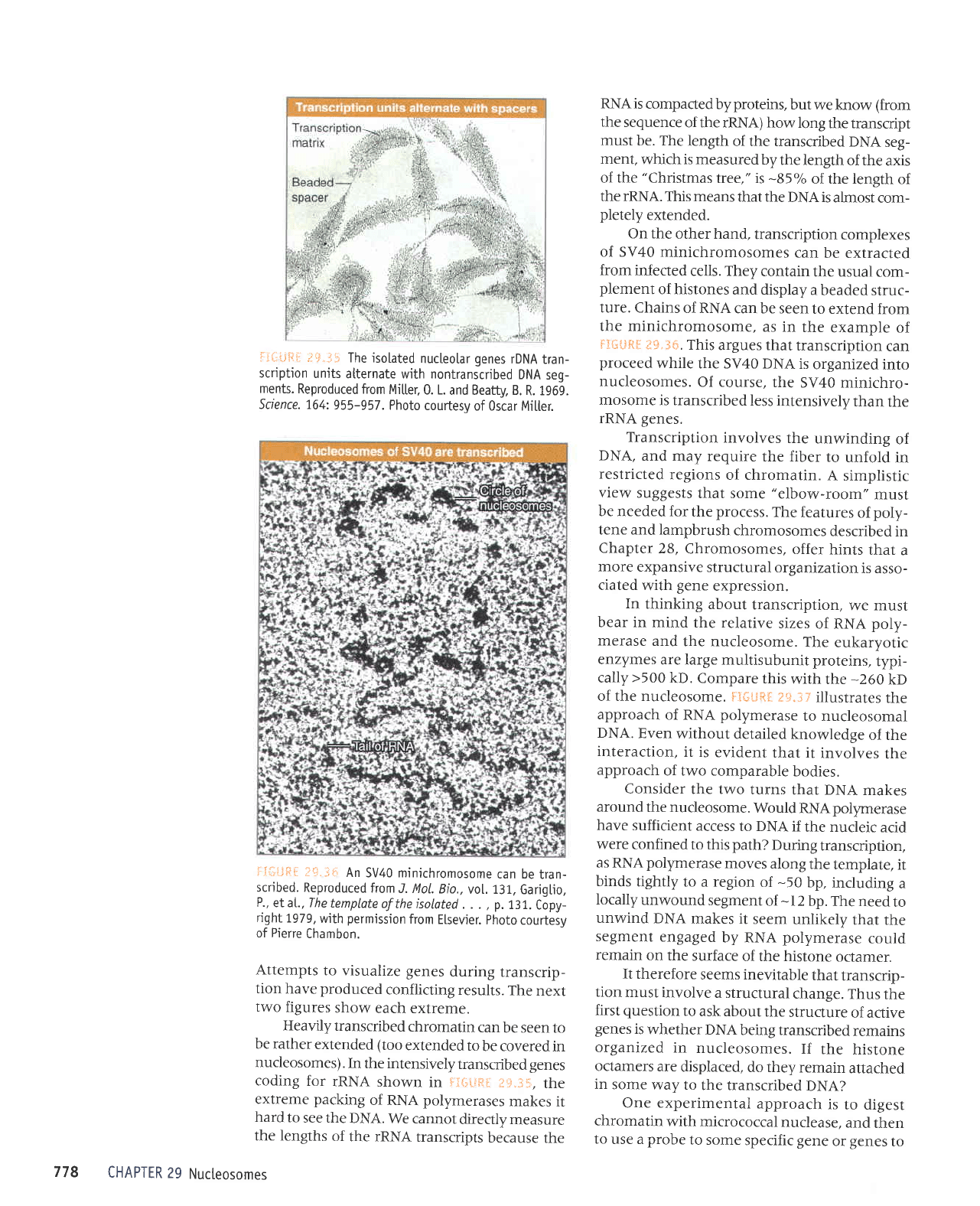
ii*l-iFi
I*"-l=
The isolated
nucleolar
genes
rDNA
tran-
scription
unjts
atternate with nontranscribed
DNA
seg-
ments.
Reproduced
from
Mitter,
0. L.
and Beatty, B.
R. 1969.
Science. 1.64:955-957.
Photo
courtesv
of 0scar
Mitter.
iISliFI
f$.s+
An
SV40 minichromosome
can be
tran-
scribed.
Reproduced
from
J. Mol.
Bio.,
vol.131.
GarigLio,
P.,
et at., The
template
of
the isoLated
. . .
,
p.131.
Copy-
right1.979,
with
permission
from
Elsevier.
photo
courtesv
of Pierre
Chambon.
Attempts
to visualize genes
during
transcrip-
tion
have produced
conflicting
results.
The
next
two
figures
show
each extreme.
Heavily
transcribed
chromatin
can
be seen
to
be rather
extended
(too
extended
to
be covered
in
nucleosomes).
In
the intensively
transcribed
genes
coding
for
rRNA
shown
in
FItil.tfr$:
t'"+.jt$,
the
extreme
packing
of RNA
polymerases
makes
it
hard
to
see the
DNA.
We cannot
directly
measure
the lengths
of
the rRNA
transcripts
because
the
Nucteosomes
RNA is
compacted
by
proteins,
but
we know
(from
the
sequence
of the rRNA)
how long
the transcript
must
be. The
length
of the transcribed
DNA
seg-
ment.
which is measured
by
the length
of the
axis
of the
"Christmas
tree," is
-85%
of the length
of
the rRNA.
This means
that the
DNAis
almost
com-
pletely
extended.
On the
other hand,
transcription
complexes
of SV40
minichromosomes
can
be extracted
from
infected
cells. They
contain
the usual
com-
plement
of histones
and display
a
beaded
struc-
ture. Chains
of RNA
can be seen
to extend
from
the minichromosome,
as in
the
example
of
Fi{;|ifiil
t*"}*.
This
argues that
transcription
can
proceed
while
the SV40 DNA
is
organized
into
nucleosomes.
Of course,
the
SV40 minichro-
mosome
is transcribed
less intensively
than
the
rRNA
genes.
Transcription
involves
the
unwinding
of
DNA,
and
may require
the fiber
ro
unfold
in
restricted
regions
of chromatin.
A simplistic
view
suggests
that some
"elbow-room"
must
be needed for
the
process.
The
features
of
poly-
tene and
lampbrush
chromosomes
described
in
Chapter
28,
Chromosomes,
offer
hints
that
a
more
expansive
structural
organization
is asso-
ciated with
gene
expression.
In
thinking
about
transcription,
we must
bear in mind
the relative
sizes
of RNA
poly-
merase
and
the nucleosome.
The
eukaryotic
enzymes
are large multisubunit
proteins,
typi-
cally
>500
kD. Compare
this
wirh
the
-260
kD
of the nucleosome.
$t{#ftf,
t1;.}?
illustrates
the
approach
of RNA
polymerase
to nucleosomal
DNA.
Even
without
detailed
knowledge
of the
interaction,
it is
evident
that it
involves
the
approach
of two comparable
bodies.
Consider
the two
turns
that DNA
makes
around
the nucleosome.
Would
RNApolynerase
have
sufficient
access
to DNA
if
the nucleic
acid
were
confined
to this
path?
During
transcription,
as RNA
polymerase
moves
along
the
template,
it
binds
tightly
to a region
of
-50
bp,
including
a
Iocally
unwound
segmentol-l2bp.
The
need
to
unwind
DNA
makes it
seem
unlikely
that the
segment
engaged
by RNA
polymerase
could
remain
on the
surface
of the histone
octamer.
It therefore
seems inevitable
that
transcrip-
tion
must
involve
a structural
change.
Thus
the
first
question
to
ask about
the
structure
of active
genes
is
whether
DNA
being transcribed
remains
organized
in
nucleosomes.
If
the
histone
octamers
are
displaced,
do they
remain
attached
in
some
way to
the transcribed
DNA?
One experimental
approach
is
to digest
chromatin
with
micrococcal
nuclease,
and
then
to
use a
probe
to
some
specific
gene
or
genes
to
778
CHAPTER
29
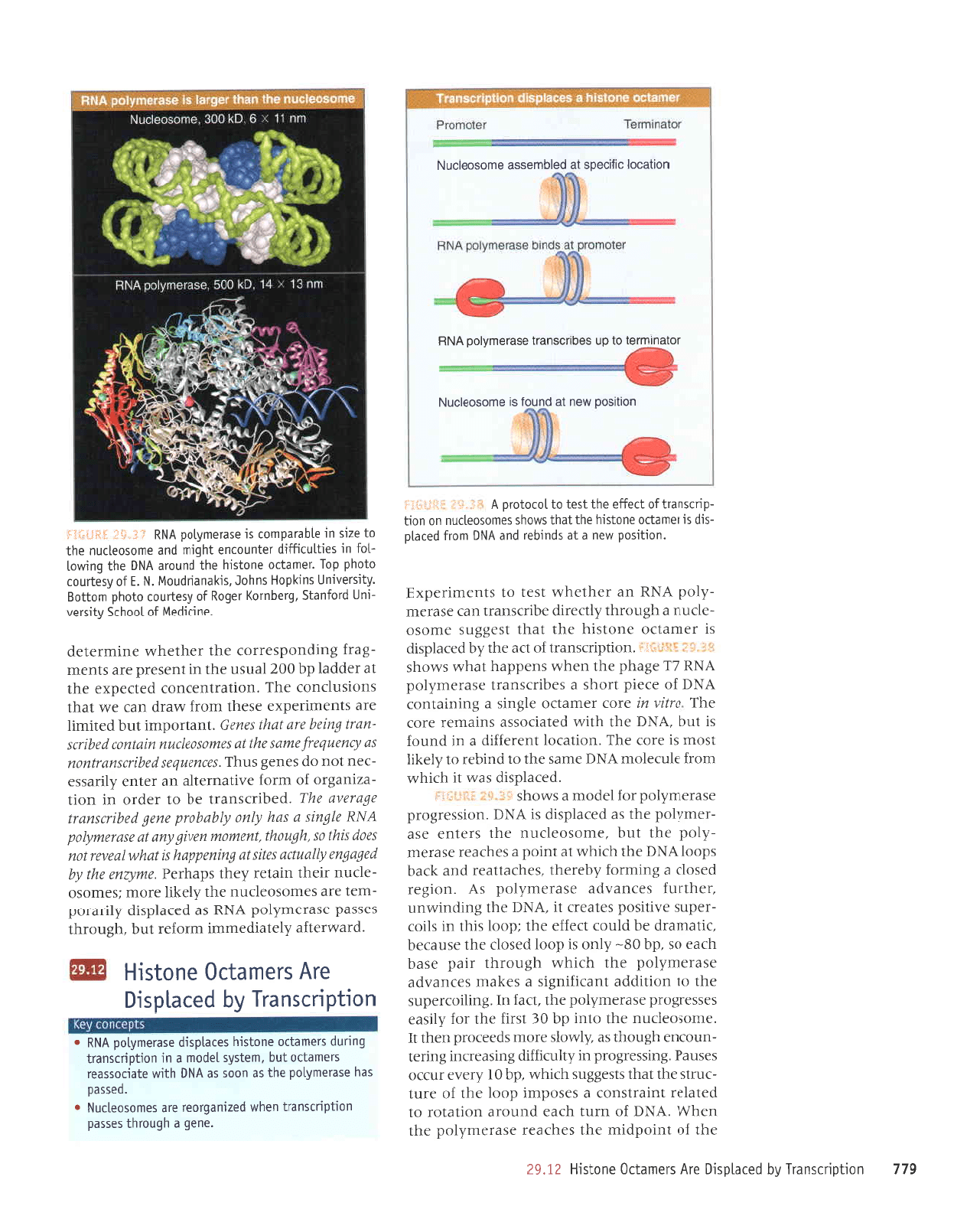
6LL
uorldulsup.ll
[q
pa:e1dsL6
alv srauepg auo]srH
Zl'62
eqt
Io
turodpru
Jql sJqJpaJ
aseraurrllod
aqt
uJqM
'vN(
Jo
urnl
qJPs
punorP
uolleloJ
ol
pJtelal
turerlsuoJ
e sasodurt
dool aql
Jo
eJnl
-)nrts
Jql
lpqt
stsaSSns
qJIqM
'dq
g1
Araa.a
rnrto
sesned'SurssarSord ur
zlllnrrgyrp Sutseanur
Sutral
-unoJuJ
qSnoqt
se L1a,ro1s Jroru spJelord
uaql
lI
'JruosoelJnu
eql olur dq
gg
tsrr;
aqt
ro;
[1rsea
sassarSord
aserauLlod eql
'1reJ
u1
'Surlorradns
eqt ot uorlrppe
tuert;tu8ts
e sJ>leur
sef,uelpe
aseraruLlod
Jqt
q)rqM
q8norqt
led
aseq
qJeJ
os
'dq
OS-
r{1uo sr dool
pasop Jqt Jsnelaq
'JrteupJp
eq
plnoJ
DJIIJ
Jql
:doo1 stqt
uI sltoJ
-radns
aa.rtrsod saleJJJ
ll
'vN(
aql
Surpultrun
'rJqunJ
sa)upApp aserauLlod
sy
'uorSar
pJSolJ
e Sururo;
^qaJeql
'sJq)ettpal
pup >lJeq
sdool
ygq
aqt
qJrqM
te
tutod
e sJqJeer
aseJJur
-,{1od
aqr
tnq
'JuosoelJnu
JI{r srJtuJ
JSe
-raurLlod
aql se
pareldslp
sl
VNo
'uotssarSord
aserarudlodroJlJpou
P sMoQS_i,1
r,,
irr,'ii
j
'pareldsrp
sP^\
lI
qJIqM
uorJ JInJJIoru
vNo
eues
Jqt ot
puIqJJ
cll
^lJ{ll
lsoru
sr
eror JqJ
'uolleJol
IUJJJJJIp
P
ul
punoJ
sr
lnq
'vNq
Jr{l
qlrM
pJIPIIOSSP
SuIPruJ-I
aJoJ
eql lutr
ut
JroJ
Jeuret)o a18uts
e Sututeluor
VN(
Jo
a:ard
uoqs
p
sJqIJJSueJt
aseraut.dlod
VNU
/J
a8eqd eqt uaqM suaddeq
teqM
smoqs
:.':
,,,.i
r.1,,::.j
I
'uorldr.rrsue.11
Io
lJp
aql ,{q
pareldsrp
sr JJruplJo euolslq Jqt
lpql
tsaSSns
JIUoso
-elJnu
e
q8norqt
r(lnarrp eqlJ)sueJt
ue)
JSeJJru
-z(1od
ytrlg
ue JeqlJqM
tsJt
01 stuauuadxg
'uorltsod
Mou
e
]p
sputqal
pue
VNo
trlolJ
palelo
-srp
sr raurepo auolsrq aq]
lPql
sMoqs saulosoallnu
uo uou
-clulsuelljo
lla#a
aqllsal 01l0lolo]0
V
r,f
':,.r
il!::r:l.ij
'auab
e
qbnolql sassed
uorldursuell
ueqrvr
pazruebtoat olP sauosoallnN
o
'passP0
seq aseraurtlod
aql sP uoos
sP
VN0
qlm
elel]osseol
sraupllo
1nq
'ua1sr{s
lapoul
P ut uoLldursuerl
6uunp
srauelro
ouolsrq
sareldsrp
eselaur{1od
y1g
.
uoqdulsuerl
Aq
paleldst6
aJV
sjauPll0
auolsLH
'pJpMJJUe
Llalerparurul
ruJoJJr
1nq
'q8norqt
sassed
aseraurr(1od
VNU
se
pareldsrp z{.perod
-urJl
eJP SJuTOSOJIJnu
aqt
,{.1a41 JJOUr
lsJruoso
-elf,nu
Jraql
uleleJ.daql
sdeqra4
aut[zua
a41 fq
pa6a6ua [11uru)o
safls
p
6uruadda4
s7
loLlw
loz^al
Pu
salp
slt4i os
'46no4l'luawlut
uan6
[ua
p
asanwQod
y1t1y
a16uts
a sa4
[1uo
fiqaqotd
aua6
paqtnsuutl
aFatala
aL.lJ'peqrDsueJl
JQ 01
JepJo uI
uoll
-eaue?to
Jo
ruJoJ JAIIPuJJI1P
uP
JJluJ
r{pessa
-f,eu
lou
op saua8
sruq7'satuanbas
paqu)suoJlulu
sa
[cuanba$
au,uts
aLflp sautzsoapnuutaluu
paqu)s
-ua4
6utaq alo
p4l
sauag'tuevodtut 1nq
pJllrull
are
sluetulrJdxa
asaql
uorJ
Melp uel
J,rt
leql
suorsnlJuoJ
JqJ
'UOIIPJIUJJuOJ
palladxa aqr
te
rJppel
dq
OOZ
Iensn
aql ut
luasard
JJe sluJlu
-3er;
Surpuodsarrot
Jqt
JeqlaqM
eulruJJlap
'auDrpo6
;o
1ooq15
fltstan
-run
proJuels'6raquro;
ta6og;o
fsaynor
oloqd
uo11og
'fi1Lsranru1
surldog
suqoC'stleuPupnohl
'N '3
;o
r\selnor
oloqd
do1
'leulPllo
euolslq
eql
punolP
VNC
eql Dut/t^ol
JoJ
ur sarllnrlJ1tp
lelunolue
lqbLu
pue
aulosoallnu
aql
ol
ezrs ur
alqereduor
sL ase.raufilod
VNU
j.il'i';;1
,{t{i1:,liri
uollrsoo
Meu
le
punol
sr ourosoalcnN
Joleururol o1 dn sequcsuerl
esereur{|od
ypg
uorlecol
cllrcods
le
pelquesse
ouosoolcnN
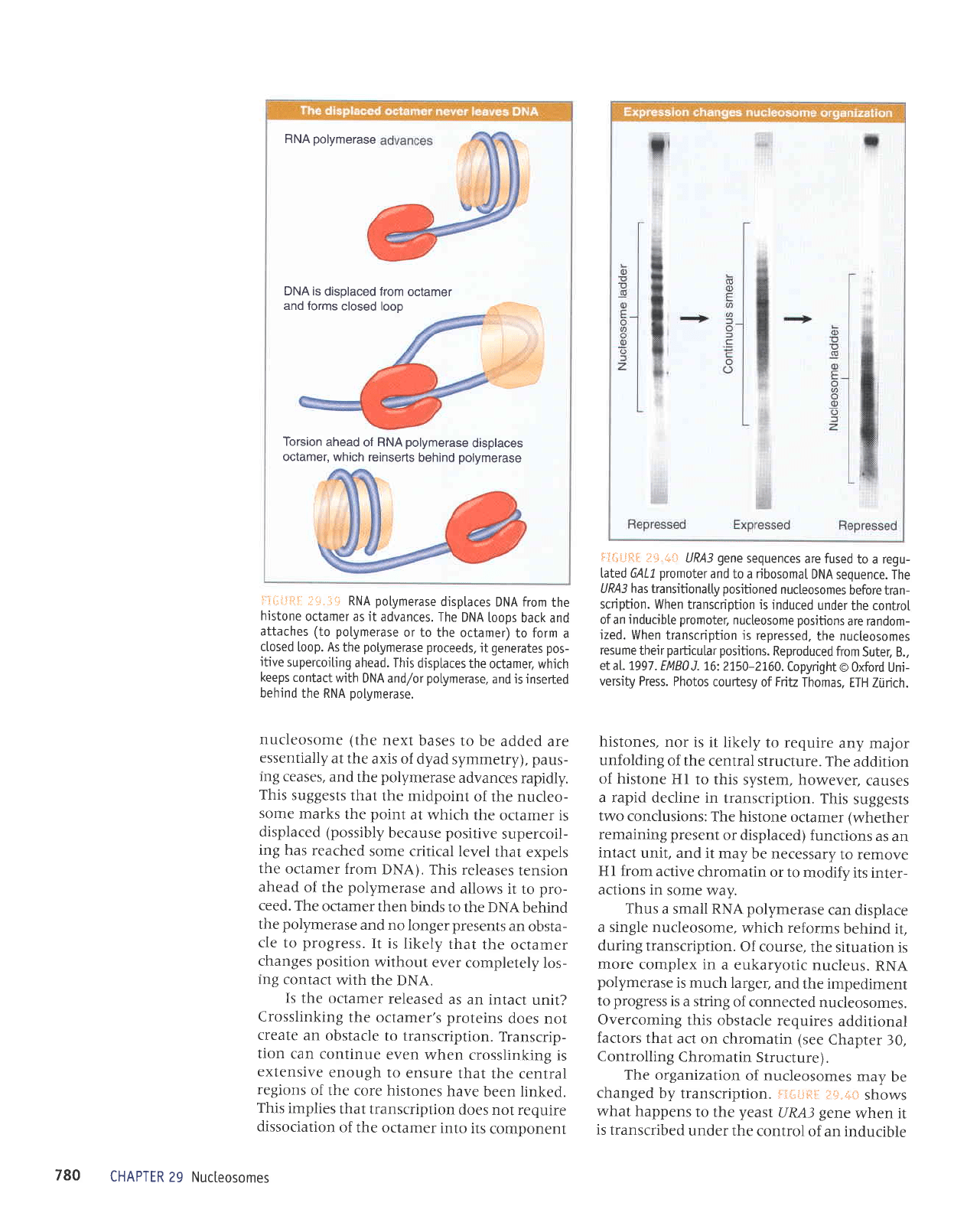
RNA
polymerase
Torsion
ahead
of RNA
polymerase
displaces
octamer, which
reinserts
behind
polymerase
DNA is
displaced from
octamer
and forms
closed looo
l':iil"!*l
:i;.-i-i: RNA
polymerase
disptaces
DNA from
the
histone
octamer as it
advances. The
DNA
loons
back and
attaches (to polymerase
or to
the octamer)
to form
a
closed
[oop. As
the
pol.ymerase
proceeds,
it
generates
pos-
itive
supercoiling
ahead. This
disp[aces
the
octamer, whjch
keeps
contact
with
DNA and/or
polymerase.
and is inserted
behjnd
the RNA
polymerase.
nucleosome
(the
next
bases to
be added
are
essentially
at the
axis of
dyad symmetry), paus-
rng
ceases,
and
the
polymerase
advances
rapidly.
This
suggests
that
the midpoint
of the nucleo-
some
marks
the
point
at which
the
octamer is
displaced
(possibly
because positive
supercoil-
ing
has reached
some
critical level
that
expels
the
octamer
from
DNA).
This releases
tension
ahead
of the
polymerase
and allows
it to
pro-
ceed.
The
octamer
then
binds
to the DNA
behind
the
polymerase
and no
longer
presents
an
obsta-
cle
to
progress.
It
is likely
that
the
octamer
changes position
without
ever
completely
los-
rng
contact
with
the DNA.
Is
the
octamer
released
as an intact
unit?
Crosslinking
the
octamer's
proteins
does not
create
an
obstacle
to transcription.
Transcrip-
tion
can continue
even
when
crosslinking
is
extensive
enough
to
ensure
that
the central
regions
of
the core histones
have
been linked.
Ihis
implies
that transcription
does
not require
Cissociation
of
the octamer
into
its
component
CHAPTER
29 Nucteosomes
FT$#fii:,
tL;-+*
URl3
gene
sequences
are fused
to a regu-
lated GALL
promoter
and
to a
ribosomaI
DNA
sequence. The
UR43 has transitionatty
positioned
nucleosomes
before tran-
scription. When
transcription is
induced
under
the control
of an
inducibte promoter,
nucleosome
positions
are random-
ized.
When transcription
is repressed,
the nucteosomes
resume
their
paticu[ar positions.
Reproduced
from
Suter. B.,
et at. L997.
EMBO
J.
1.6:21,50-21,60.
Copyright
O 0xford Uni-
versity Press.
Photos
courtesy
of
Fritz
Thomas,
ETH
Zi.irich.
histones,
nor
is it likely
to require
any major
unfolding
of the
central structure.
The
addition
of histone
Hl
to this
system, however,
causes
a rapid
decline in
transcription.
This
suggests
two
conclusions:
The histone
octamer
(whether
remaining present
or displaced)
functions
as
an
intact
unit, and
it may
be necessary
to remove
Hl from
active
chromatin
or to
modify
its inter-
actions in
some
way.
Thus
a small RNA
polymerase
can
displace
a single
nucleosome,
which
reforms
behind
it,
during
transcription.
Of course,
the
situation
is
more
complex in
a eukaryotic
nucleus.
RNA
polymerase
is
much larger,
and
the impediment
to
progress
is
a string
of connected
nucleosomes.
Overcoming
this obstacle
requires
additional
factors
that
act on
chromatin (see
Chapter
30,
Controlling
Chromatin
Structure).
The
organization
of nucleosomes
may
be
changed
by
transcription.
i1i*i:fiil
?+.4t]
shows
what
happens
to the
yeast
URA3
gene
when it
is
transcribed
under the
control
of an
inducible
780
